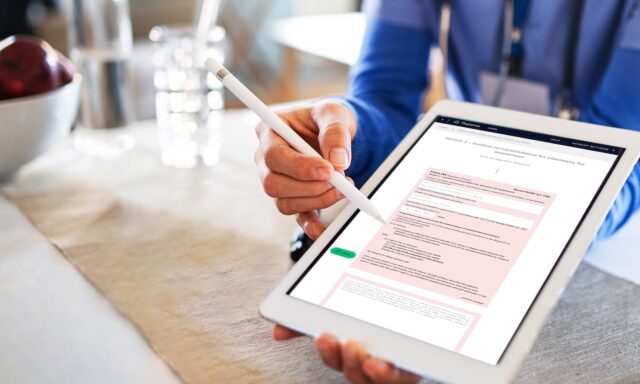
At Thalamos, robust, real-world product testing isn’t just a development checkbox — it’s a fundamental part of how products are built to deliver safe, effective outcomes in high-stakes mental health settings.
To explore what that looks like in practice, we sat down with two of the team: Product Manager Maya Lekkas and Senior Product Designer Johan Nordin. They are part of a wider group that lead on user testing efforts — most recently for a new digital workflow designed for police officers completing Section 136 processes under the Mental Health Act.
Building with, not just for, frontline user
The latest police product is the result of months of design, consultation and iteration. But before it’s rolled out, it has to pass the most important test: does it actually work for the people using it in the field?
User testing sessions with police forces in different parts of the country focused on one thing above all: usability. Can officers use the system effectively? Do they understand each step in the process? And is the software built with the understanding that there are very regional differences in how Section 136 procedures are carried out?
What emerged was a clear picture of just how varied practices can be — not just between organisations, but within teams. Testing sessions weren’t just about observing interaction with a screen, but about actively surfacing where those differences lie, and understanding how to guide users toward consistent, safe, and lawful approaches.
Designing for edge cases — without over-engineering
One recurring challenge in testing has been striking the right balance between supporting rare but high-risk scenarios and keeping the core workflow intuitive for everyday use. With the new police product, the team initially designed for the most complex possible Section 136 scenarios — where multiple places of safety, delayed transfers, and overlapping responsibilities might all come into play.
As testing has expanded to areas outside London, the team has seen that many forces follow far more straightforward workflows. This prompted a healthy internal debate: are we overcomplicating the user experience for most users in an effort to protect against rare scenarios?
Rather than choosing one over the other, Thalamos takes a design-for-durability approach. The system must hold up under pressure — even in edge cases — but remain streamlined enough for the 90% of situations that don’t require extra layers of complexity. Future testing sessions, especially in London where complexity is more common, will further shape how that balance is maintained.
Testing what you don’t know to test
The Thalamos user testing approach is intentionally open and broad. Sessions aren’t rigidly structured around scripted tasks or checklists. Instead, the team aims to create space for the unknown — the assumptions no one realised they were making, and the insights users may not think to offer unless they feel safe and heard.
Rather than leading with overly specific tasks ( e.g. “click this button”), sessions start with broad questions and let users move through the system more naturally. That freedom often reveals where real issues lie: the moments where hesitation creeps in, where terminology feels unclear, or where the user chooses a shortcut that could jeopardise the outcome.
Across the board, the approach is shaped by active listening and close observation. Sometimes, the way a user hovers over a screen element — or rereads a line of text several times — tells the team more than a verbal answer ever could. Equally, it’s crucial to consider not just what users say, but the potential consequences of misunderstanding. In some cases, misunderstanding a step in the process might simply slow someone down. In others, it could jeopardise the legal status of a detention or delay care for someone in crisis.
“You don’t test to see if people like it. You test to see if they understand it.”
Capturing, categorising, and actioning feedback
After each session, feedback is gathered, reviewed and prioritised. Inputs are typically categorised by risk: red for critical blockers that must be addressed before going live; amber for significant issues that may affect data or experience; and yellow for minor usability concerns.
This process ensures feedback doesn’t just sit in a spreadsheet. High-risk issues are tackled immediately. Lower-priority items are triaged into future development sprints or logged for further monitoring.
At times, the team also has to resist the urge to overreact to early feedback. Some misunderstandings resolve naturally once a user has tried the product a few times, or after peer-to-peer knowledge sharing within teams. One of the ongoing challenges is distinguishing between issues that will fade with familiarity and those that indicate genuine design flaws.
“Designing for edge cases protects the system — but it can’t come at the cost of everyday usability.”
Balancing user input with clinical outcomes
While user feedback drives much of Thalamos product development, it’s never the only voice in the room.
Unlike in some tech environments where the “user is always right”, Thalamos products also need to meet stringent standards in clinical safety, legal compliance, and information governance. That means balancing frontline usability with deeper ethical and regulatory considerations — especially when a product captures data that could one day influence service-level decisions or national policy.
This is where the Thalamos Responsible Innovation Group (RIG) plays a vital role. Every new feature is reviewed by the RIG — a multi-disciplinary panel that brings together expertise in mental health law, clinical safety, living experience, and data governance.
The RIG’s reviews ensure that user feedback doesn’t result in short-term ease at the expense of long-term safety or fairness. It means that every product decision is tested not just against what users want, but also against what patients need, what regulations require, and what the system can safely sustain.
“Real insight comes from what users don’t say — the hesitation, the repetition, the workaround.”
Making adoption work
Adoption isn’t always just about preference. In many NHS and police contexts, using new software is non-negotiable. But that doesn’t mean adoption happens smoothly by default. Thalamos knows that mandatory software, if poorly designed or introduced without testing, can lead to frustrated users, skipped training, and minimal engagement with the parts of the product that matter most.
That’s why the team takes extra care to engage users as early as possible. When people see their feedback genuinely shaping a product, they’re far more likely to support its rollout — and advocate for it with their peers. This sense of ownership can be the difference between passive compliance and active, confident use.
Interestingly, when software is optional, adoption patterns shift. Users who don’t like it simply stop using it. Those who stay tend to engage more deeply and generate higher-quality data. That contrast underlines why good testing and feedback loops are essential, no matter the model.
“User testing is where we listen, but the Responsible Innovation Group is where we challenge ourselves to act responsibly on what we hear.”
Testing doesn’t stop at go-live
A key lesson from past launches is that even the most comprehensive user testing can’t predict everything. That’s why user insight doesn’t stop once the product goes live.
During rollout phases, Thalamos continues to observe, gather feedback, and make adjustments. What matters most is how real users interact with the software in real-world conditions — during busy shifts, under time pressure, or in environments full of distraction and stress.
Early adopters often become trusted partners in this phase, offering ongoing insight into how features are performing over time. The team also reviews live usage data to understand where users are getting stuck, skipping steps, or behaving in ways that suggest confusion or friction.
These live insights feed directly into future iterations, making user testing a living part of the product lifecycle — not a one-off event.
Stronger adoption, safer systems
Ultimately, user testing at Thalamos is not about perfection, it’s about building confidence. For customers, it demonstrates due diligence. For users, it improves adoption by making tools genuinely easier to engage with. And for patients, it supports better care by reducing risk and ensuring data integrity.
Testing also isn’t the end of the story. Pilots, real-world rollouts and ongoing iteration all play their part. But it is a vital early step in ensuring that every Thalamos product is grounded in the lived reality of those who use it, and shaped with equal care for the safety of those it supports.
Three key drivers of Thalamos product testing
(1) Real-world usability
Products must be intuitive and effective for frontline users — even in high-pressure, low-training environments.
(2) Responsible innovation
Every feature is tested not just for user preference, but for clinical safety, legal compliance, and patient impact — guided by our Responsible Innovation Group.
(3) Iterative insight
Testing doesn’t stop at launch. Feedback from pilots, live use, and diverse user groups continuously shapes and strengthens our products.
Johan Nordin has held a number of product, experience and user experience designer roles in the management consultancy and digital space where he led UX design teams on work including a tool used at the UN Climate Change Conference in 2021. At Thalamos he is the senior designer, creating new product features. Working closely with the product team, he designed a mobile-optimised software platform for police and health users navigating a section 136 process.
Maya Lekkas built her product experience in the consumer space at Virgin Media O2 where she spearheaded the trial and launch of a multi-billion full-fibre broadband network and a cybersecurity service. At Thalamos she leads the development and delivery of a new police software to be used nationally — digitising key mental health pathways involving the police and health services.
If you’ve found this article valuable then sign up to our monthly mental health briefing newsletter to access future insights.


